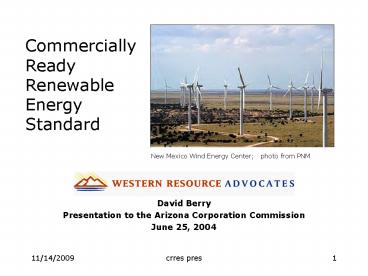Commercially Ready Renewable Energy Standard - PowerPoint PPT Presentation
1 / 18
Title:
Commercially Ready Renewable Energy Standard
Description:
Wind, biomass, solar, and geothermal resources can serve as a hedge against ... Eligible resources: new geothermal, wind, biomass (excluding municipal solid ... – PowerPoint PPT presentation
Number of Views:36
Avg rating:3.0/5.0
Title: Commercially Ready Renewable Energy Standard
1
Commercially Ready Renewable Energy Standard
New Mexico Wind Energy Center photo from PNM
- David Berry
- Presentation to the Arizona Corporation
Commission - June 25, 2004
2
Utilities operate in a risky world
Future environmental regulation
High gas prices
Risk
Cost
Inadequate transmission capacity
Prolonged drought
3
CRRES DEPS manage these risks
- Renewable energy provides a hedge against high
natural gas prices - Renewable energy provides a hedge against the
costs of complying with future carbon dioxide,
sulfur dioxide, and nitrogen oxide regulations - Wind, biomass, solar, and geothermal resources
can serve as a hedge against reduced hydropower
resources during periods of prolonged drought - Distributed generation, including photovoltaics,
reduces the need to build additional transmission
capacity to load centers
4
Commercially deployed technologies in the
Southwest
5
Commercially deployed technologies in the
Southwest by state
6
The Commercially Ready Renewable Energy Standard
(CRRES)
- Pertains to renewable energy resources above and
beyond the DEPS (existing EPS) - Costs up to 0.05 per kWh above displaced
conventional generation cost - Standard gradually increases from 0 of retail
sales in 2005 to 8 by 2010 and thereafter - No extra credit multipliers
- Eligible resources new geothermal, wind,
biomass (excluding municipal solid waste and tire
burning), low impact hydro, and solar energy
resources - Location of resources in Arizona or other
states but energy delivered to AZ
7
CRRES continued
- Commission is to form a working group to
recommend a standard for years after 2010 based
on experience - Flexibility Commission can modify CRRES annual
production goals if renewable resource projects
cannot be permitted or financed, if transmission
cannot be obtained in a timely manner, etc. - Cost recovery through power supply adjustor or
portfolio standard adjustor established in rate
cases - Account for the value of environmental benefits
of renewable energy - e.g., at prices of tradable environmental credits
attributable to renewable energy, or - credit revenues from sale of environmental
credits to CRRES account
8
Renewable energy in art
Wind energy
Geothermal energy
9
Gross costs of large generic renewable energy
projects
Costs will be project specific
10
Renewable resource capacity value
- Solar and wind resources are intermittent.
- Intermittent renewable resources are credited
with capacity value less than 100 of nameplate
capacity. - Utilities back up specific resources with their
entire systems. Capacity credits are determined
from an analysis of system reliability as
intermittent resources are added to the system. - APS found that for up to 100 MW of PV generation,
tracking PV systems contribute about 80 capacity
value to the system and fixed PV systems
contribute about 60. Wind capacity credits
have been found to be between about 13 and 30
of nameplate capacity. - Paul Smith, Value of Solar Thermal and
Photovoltaic Power Plants to Arizona Public
Service Company, ASME International Solar Energy
Conference, 1994.
11
Effect of natural gas prices
- In contrast to gas prices, renewable energy
prices are often fixed or stable -- not volatile
or increasing over time - The CRRES is a useful hedge against high gas
prices - A hedge limits utility and consumer exposure to
high gas prices
Trend 3 real growth rate
12
Net cost of proposed CRRES
- Net cost gross cost of renewable energy
contracts avoided conventional energy and
capacity costs (gas coal units) market value
of environmental credits derived from renewable
energy - CRRES 2 of retail sales (over and above DEPS)
in 2006, 3 in 2007, 4 in 2008, 6 in 2009, 8
in 2010 - Natural gas price trend value in 2004 4.92 per
MMBtu in 2004 (see previous graph actual cost
is above the trend at 6.11 per MMBtu per June
2004 Short Term Energy Outlook) - Assumed illustrative mix of renewable energy MWH
geothermal 12, wind 86.9, pv 0.1,
biomass 1. - More details in the appendix and spreadsheet
13
Illustrative mix of renewable energy resources
- Resource mix depends on utility and developer
circumstances - Wind constitutes major resource
- low cost
- abundant in west, including AZ and NM
- Geothermal -- existing resources in southern CA
and possible resources in AZ - Biomass resources AZ has landfill gas and
forest biomass - Solar resources -- AZ has abundant solar resources
14
Net cost of the CRRES is negative
15
The CRRES reduces air emissions
- Emission reductions by 2010
- SO2 10 of AZ power plant emissions in 2002
- NOx 10 of AZ power plant emissions in 2002
- CO2 8 of AZ power plant emissions in 2002
16
Conclusion -- The CRRES
- Is feasible
- Is cost effective
- Hedges against high natural gas prices
- Improves air quality and reduces exposure to
costs of future air quality and climate change
regulation - Advances new generation technologies
- Is in the public interest
17
Appendix other major assumptions
- Growth rate of retail kWh sales 3.9 per year
- 5 TD losses
- Gas units are marginal units 35 of time, coal
units are marginal units 65 of time - Marginal coal unit fuel price is 1.51 per MMBtu
in 2004 escalating at a real rate of 0.77 per
year - Marginal gas unit fuel price is 4.92 per MMBtu
in 2004 escalating at a real rate of 3.0 per
year (this is the trend line price, not actual
price) - Heat rates of marginal units coal 10,684
Btu/kWh, gas 10,000 Btu/kWh - Environmental credit prices SO2 170 per ton,
NOx 2000 per ton, CO2 3.64 per metric ton
Detailed assumptions available on separate
spreadsheet
18
More renewable energy in art
Biomass
Hydropower































